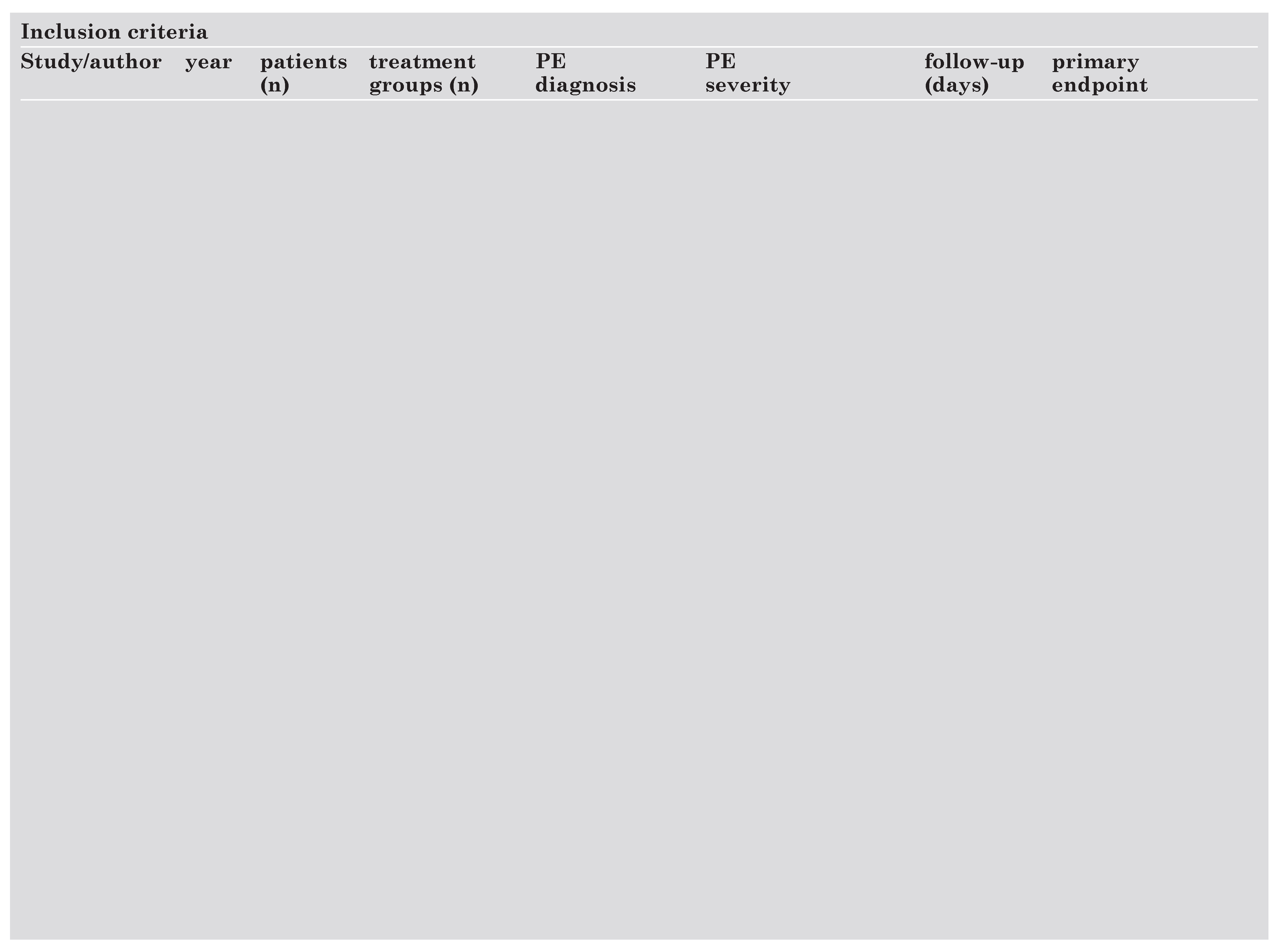Abstract
Physicians caring for patients with acute pulmonary embolism (PE) are often faced with the dilemma whether to «limit» therapy to heparin anticoagulation or administer thrombolytics. Assessment of right ventricular dysfunction may be useful in guiding therapeutic decisions in PE. Haemodynamically stable patients without echocardiographic (or CT) evidence of right ventricular (RV) dysfunction (non-massive PE) have an excellent in-hospital prognosis and should thus be treated with heparin alone, preferably with weight-adjusted low molecular weight heparin. At the other end of the spectrum, unstable patients in cardiogenic shock (massive PE) must receive immediate thrombolysis or, in the presence of absolute contraindications to thrombolytic agents, undergo interventional or surgical pulmonary artery recanalisation. Recently, evidence has accumulated that normotensive patients with RV dysfunction (submassive PE) may also have a high mortality and complication risk during the acute phase. To date, only one study has investigated the possible benefits of thrombolysis compared to heparin alone in this latter patient population. Although the study could show a significant difference in favor of thrombolysis wirth regard to the primary combined end point (mortality or need for escalation of treatment), it did not find a pure survival benefit for patients receiving thrombolytic treatment. The optimal treatment (thrombolysis vs heparin alone) of patients with submassive PE will now be addressed by a large multinational controlled trial which is about to begin very soon.
Zusammenfassung
Die kritische therapeutische Fragestellung bei der akuten Lungenembolie ist, ob ein Patient allein mit Heparin (unfraktioniert oder niedermolekular) behandelt werden kann, oder ob darüber hinaus eine thrombolytische Behandlung erforderlich ist. Dazu dient die Risikostratifizierung anhand der hämodynamischen Stabilität und des Vorliegens einer rechtsventrikulären (RV) Dysfunktion. Bei hämodynamisch stabilen Patienten ohne RVDysfunktion im Echokardiogramm (oder CT) ist angesichts der exzellenten Akutprognose die Antikoagulation mit Heparin ausreichend, und es besteht keine Indikation zur Thrombolyse oder mechanischen Rekanalisation. Die gewichtsadaptierte Injektion eines niedermolekularen Heparins ist für die meisten Patienten dieser Gruppe die Therapie der Wahl. Hämodynamisch instabile Patienten mit kardiogenem Schock oder reanimationspflichtigem Kreislaufkollaps (massive Lungenembolie) haben andererseits ein hohes Risiko, an der Lungenembolie zu versterben. Daher besteht Konsens, auch ohne ausreichende Evidenz durch kontrollierte Studien, dass sie einer sofortigen Rekanalisationstherapie bedürfen. Bei absoluter Kontraindikation gegen die Thrombolyse können, je nach lokaler Verfügbarkeit und Expertise, mechanische Rekanalisationsverfahren angewendet werden. Umstritten ist dagegen das Vorgehen bei hämodynamisch stabilen Patienten mit RV-Dysfunktion (sog. submassive Lungenembolie). Die Ergebnisse zahlreicher Untersuchungen unterstützen die These, dass Patienten mit normalem arteriellem Blutdruck aber Nachweis einer RV-Dysfunktion mittels Biomarker und Echokardiographie eine ungünstige Prognose haben. Die einzige kontrollierte Studie, welche sich auf die möglichen prognostischen Vorteile einer Therapie mit Alteplase bei stabilen Patienten mit RV-Dysfunktion konzentrierte, konnte eine signifikante Reduktion des primären kombinierten Endpunktes «Mortalität oder Therapieeskalation» nachweisen. Da sich jedoch die Mortalität zwischen beiden Behandlungsgruppen nicht unterschied, kann noch keine allgemeine Empfehlung zur Thrombolyse ausgesprochen werden. Die Frage nach der Indikation zur Thrombolyse in dieser Patientengruppe soll demnächst durch eine grosse internationale Studie definitiv beantwortet werden.
Key words: Lungenembolie; Thrombolyse; Prognose; submassiv; Schock; Heparin
Introduction
More than 30 years have passed since the first reports on the use of thrombolytic agents in acute pulmonary embolism (PE). During this time, a number of studies demonstrated the superiority of thrombolysis compared to heparin alone for rapidly and effectively resolving pulmonary thrombi. However, this evidence has not been translated into a wide clinical acceptance of thrombolytic agents by the clinicians caring for patients with acute PE. In particular, while there is consensus that thrombolysis is mandatory in the minority of patients who present with massive PE and cardiogenic shock [1], the appropriate treatment of normotensive patients with acute PE remains the subject of debate [2,3]. The arguments of those opposing the use of thrombolysis in these patients can be summarised as follows [4,5]: (1.) thrombolytic therapy of PE has not been shown to reduce in-hospital or longterm mortality; (2.) the haemodynamic benefits of thrombolytic agents over heparin anticoagulation are confined to the first few days (or hours) after the beginning of treatment; and (3.) thrombolysis is associated with a high

© 2006 by the author. Attribution - Non-Commercial - NoDerivatives 4.0.